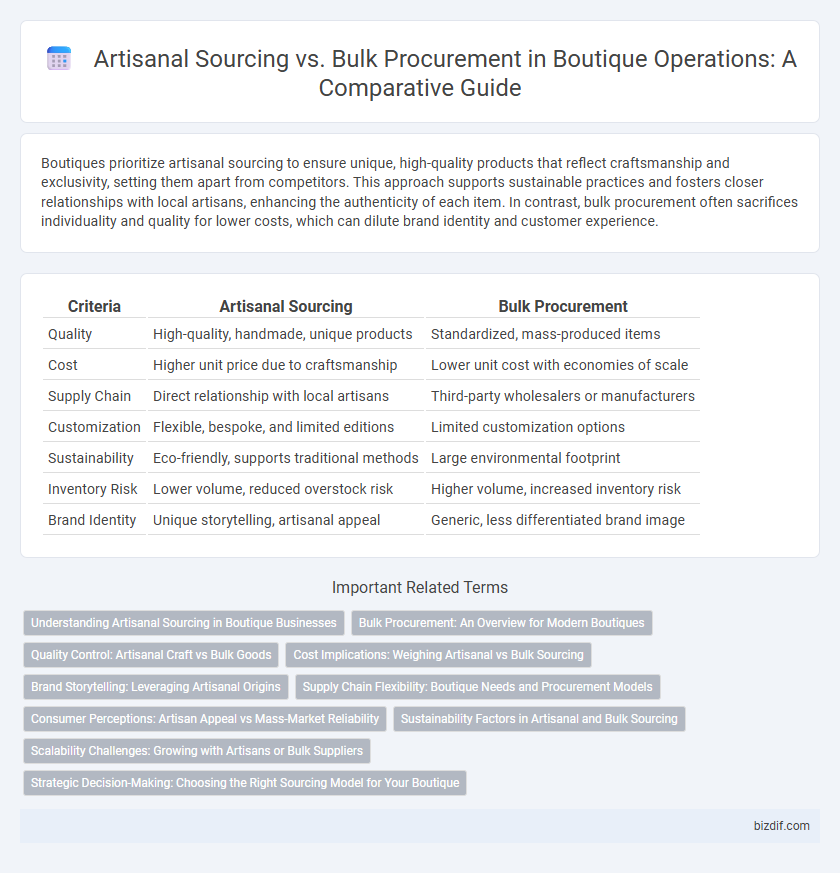Boutiques prioritize artisanal sourcing to ensure unique, high-quality products that reflect craftsmanship and exclusivity, setting them apart from competitors. This approach supports sustainable practices and fosters closer relationships with local artisans, enhancing the authenticity of each item. In contrast, bulk procurement often sacrifices individuality and quality for lower costs, which can dilute brand identity and customer experience.
Table of Comparison
| Criteria | Artisanal Sourcing | Bulk Procurement |
|---|---|---|
| Quality | High-quality, handmade, unique products | Standardized, mass-produced items |
| Cost | Higher unit price due to craftsmanship | Lower unit cost with economies of scale |
| Supply Chain | Direct relationship with local artisans | Third-party wholesalers or manufacturers |
| Customization | Flexible, bespoke, and limited editions | Limited customization options |
| Sustainability | Eco-friendly, supports traditional methods | Large environmental footprint |
| Inventory Risk | Lower volume, reduced overstock risk | Higher volume, increased inventory risk |
| Brand Identity | Unique storytelling, artisanal appeal | Generic, less differentiated brand image |
Understanding Artisanal Sourcing in Boutique Businesses
Artisanal sourcing in boutique businesses emphasizes handcrafted, unique products made by skilled artisans, fostering authenticity and craftsmanship. This approach supports local or small-scale producers, ensuring high-quality materials and sustainable practices that bulk procurement often overlooks. Understanding artisanal sourcing helps boutiques differentiate their offerings, appealing to consumers seeking exclusive, ethically-made goods.
Bulk Procurement: An Overview for Modern Boutiques
Bulk procurement allows modern boutiques to secure large volumes of inventory at reduced costs, enhancing profit margins and operational efficiency. This approach streamlines supply chain management by leveraging supplier relationships and negotiating favorable terms for consistent, high-quality product availability. Investing in bulk procurement strategies supports scalability and meets growing consumer demand without compromising on style or brand identity.
Quality Control: Artisanal Craft vs Bulk Goods
Artisanal sourcing prioritizes quality control through meticulous craftsmanship, ensuring each product reflects uniqueness and superior materials, often verified by expert artisans. Bulk procurement relies on standardized processes to maintain consistency across large volumes but may lack the nuanced quality and authenticity found in artisanal goods. This contrast highlights that boutiques valuing exclusivity and premium quality often prefer artisanal sourcing over mass-produced bulk goods.
Cost Implications: Weighing Artisanal vs Bulk Sourcing
Artisanal sourcing typically involves higher per-unit costs due to handcrafted quality and smaller production scales, impacting boutique pricing strategies and profit margins. Bulk procurement reduces expenses by leveraging economies of scale, allowing boutiques to offer competitive pricing but potentially sacrificing uniqueness and craftsmanship. Balancing cost implications requires boutiques to assess target market preferences and long-term brand positioning to optimize sourcing decisions.
Brand Storytelling: Leveraging Artisanal Origins
Artisanal sourcing emphasizes handcrafted, locally-sourced materials that enrich a boutique's brand storytelling by highlighting unique heritage and authentic craftsmanship. This approach allows boutiques to differentiate themselves from competitors reliant on bulk procurement, appealing to consumers seeking originality and ethical production. Showcasing artisanal origins in marketing campaigns strengthens emotional connections, elevating perceived value and fostering customer loyalty.
Supply Chain Flexibility: Boutique Needs and Procurement Models
Boutique businesses benefit from artisanal sourcing by gaining greater supply chain flexibility, enabling tailored, unique product offerings that align with niche customer preferences. Unlike bulk procurement, which prioritizes volume and cost-efficiency, artisanal sourcing supports adaptive inventory management and responsiveness to seasonal or trend-driven demand fluctuations. This procurement model enhances the boutique's ability to maintain exclusivity and quality, critical for sustaining brand identity and customer loyalty.
Consumer Perceptions: Artisan Appeal vs Mass-Market Reliability
Consumers often perceive artisanal sourcing as a symbol of authenticity and quality, associating boutique products with craftsmanship and uniqueness. Bulk procurement tends to evoke trust in consistency and cost-effectiveness, appealing to those who prioritize reliability and affordability. Boutique brands leveraging artisanal appeal can create stronger emotional connections, while mass-market reliability attracts a broader audience focused on practicality.
Sustainability Factors in Artisanal and Bulk Sourcing
Artisanal sourcing emphasizes sustainable practices by prioritizing small-scale, locally-owned suppliers who use environmentally friendly methods and support community livelihoods. Bulk procurement often relies on large-scale industrial processes that can lead to resource depletion and higher carbon footprints, posing sustainability challenges. The boutique sector increasingly favors artisanal sourcing to reduce environmental impact and promote ethical supply chains.
Scalability Challenges: Growing with Artisans or Bulk Suppliers
Artisanal sourcing emphasizes unique, handcrafted products from local artisans, presenting scalability challenges due to limited production capacity and slower turnaround times. Bulk procurement offers streamlined scalability with large inventory volumes, but often sacrifices product uniqueness and craftsmanship valued by boutique customers. Balancing growth requires integrating artisanal partnerships while leveraging bulk suppliers strategically to meet demand without compromising brand authenticity.
Strategic Decision-Making: Choosing the Right Sourcing Model for Your Boutique
Artisanal sourcing enhances boutique uniqueness by prioritizing handcrafted, high-quality goods from local or specialized producers, fostering exclusivity and customer loyalty. Bulk procurement offers cost efficiency and inventory consistency, ideal for boutiques targeting scale and competitive pricing strategies. Strategic decision-making involves evaluating brand positioning, customer expectations, and operational capabilities to select the sourcing model that best aligns with the boutique's long-term growth and market differentiation goals.
Artisanal Sourcing vs Bulk Procurement Infographic

 bizdif.com
bizdif.com